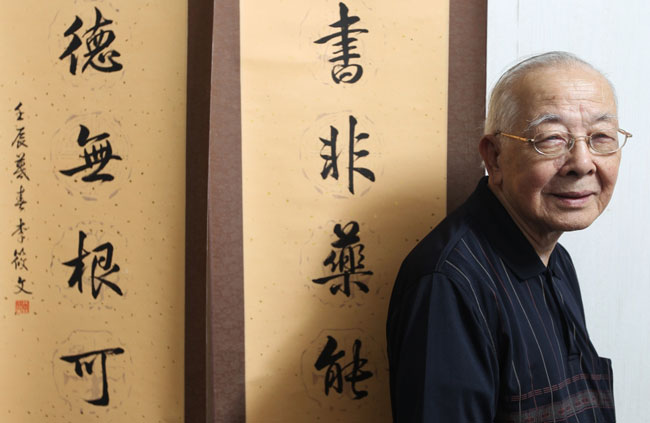Portrait of an artist as a porcelain perfectionist
When tea is served at Lee Siu-man’s flat in Kennedy Town it comes in fine porcelain cups and saucers with beautifully hand-painted peach blossom on the sides. It’s Lee’s work from half a century ago.
Around the walls are Chinese traditional portrait paintings – also painted on porcelain and fired in a furnace to bring out the colours.
Then artist Lee, 85, brings out his scrolls showing off his fine calligraphy done in the style of the Qin dynasty – uniform, neat. Then there are his scroll paintings of old characters, travellers in robes, though he admits that these days it’s easier to paint lychee and birds. “Characters take much more concentration,” he says.
Lee, a diabetic for more than 40 years, regularly goes to Ruttonjee Hospital in Wan Chai for treatment. “I have gradually formed a group of patients there and every Friday I teach calligraphy.”
Lee hosts a regular class of 20 and has watched them refine their skills and gain a sense of achievement.
“And while they are concentrating on the calligraphy and the motions of the brush, they are not having negative thoughts about their health,” he says. “I think it does help them to relax. The patients become increasingly satisfied with the process and gradually achieve more.”
In many cases it has helped them regulate their blood sugar, he says. A Ruttonjee nurse, in fact, carried out a pre and post blood sugar test on the calligraphy painters and found that their blood-sugar levels stabilised as they focused on something absorbing and therapeutic.
Lee also teaches at Diabetes Hong Kong. “Both the hospital and Diabetes Hong Kong asked me to teach painting rather than calligraphy,” he says. “But all the colours and paint are not easy to handle without creating a mess, whereas calligraphy is easier to organise.”
Lee fled from the mainland in 1949, arriving on a boat from Shantou organised by his boss who ran a porcelain workshop.
“It was the last boat to go. I was very lucky,” says Lee, who left with his family’s consent because the Nationalists were looking for young men to add to their ranks as they retreated to Taiwan “and they would have grabbed me”.
Once in Hong Kong, Lee worked at the makeshift porcelain workshop set up by his boss along Castle Peak Road. It burned down in 1951, so Lee moved to Sai Wan Ho. On and off, he continued to work with porcelain, gradually creating his own artwork to sell.
Is he expensive? “Yes,” he grins. His three children also enjoy painting, but in different styles. His two sons are designers.
“I love painting,” says Lee. “Painting on porcelain and painting on paper are very different, so I wanted to learn more at that time. “I also started painting the calligraphy prevalent in the Qin dynasty. I’m a very patient person and able to concentrate well.”
 Portrait of an artist as a porcelain perfectionist
Portrait of an artist as a porcelain perfectionistSource: www.scmp.com
Calligraphy is the art of deliberate hieroglyphic corruption and transformation in order to reach natural harmony.



